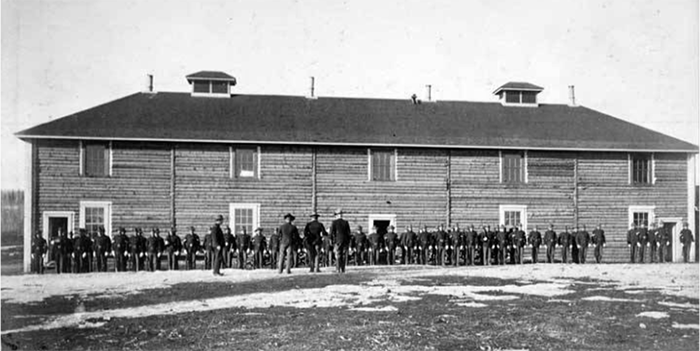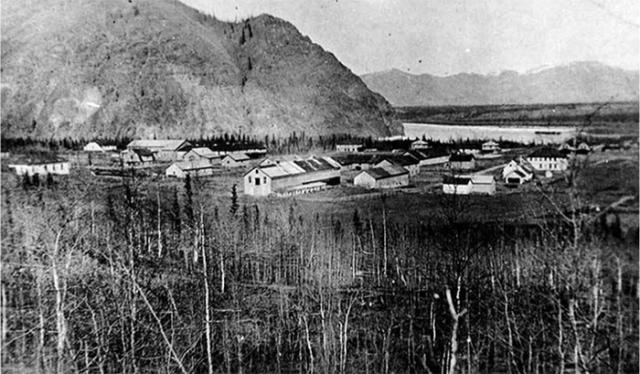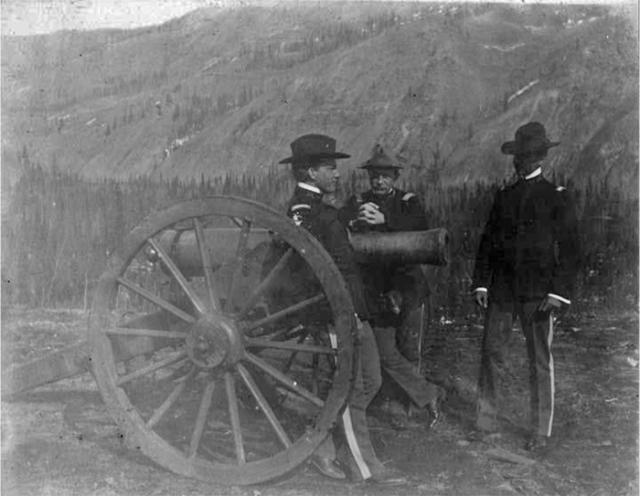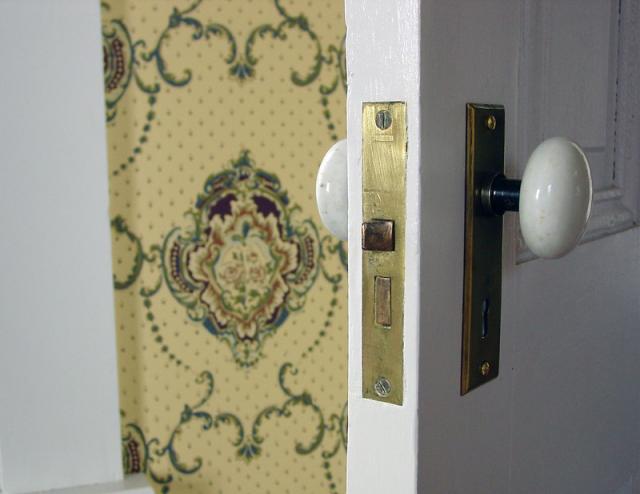
Fort Egbert
In 1899 the Fortymile region and upper Yukon valley were awash with gold miners and settlers lured in by the Klondike Gold Rush. Reports of lawlessness among the newcomers eventually reached Washington D.C. through the tortuously slow communications available at the time. The Army’s establishment of Fort Egbert on the Yukon River a few miles from Canada was to bring profound changes to the region and reshape Alaska's ties to the rest of the nation. Although the fort was largely abandoned in 1911, an Army Signal Corps contingent remained there to operate a telegraph and wireless station until 1925. Today, the BLM manages five restored structures at Fort Egbert in cooperation with the local Eagle Historical Society and Museums. The fort is part of the Eagle Historic District National Historic Landmark. Exhibits. An interpretive trail and a campground are available for visitors.

- History of the Fort
-
View of Fort Egbert around 1907 with Eagle Bluff and the Yukon River in the background. Photo courtesy of the Anchorage Museum at Rasmuson Center. The Army established Fort Egbert to provide law and order, protect commerce, care for impoverished miners, build roads and trails, and develop better communication with the nation. Construction began in 1899. In July, about one hundred enlisted men and a detachment of the Hospital Corps arrived in Eagle and began erecting barracks, officer quarters, and other facilities. Both soldiers and civilians faced adjustments to frontier living, with its limited and expensive supplies, cold, isolation, and loneliness. Many of the first buildings, hastily constructed before winter, later needed major improvements.
The following year, Fort Egbert received a new mission: to construct the first telegraph line in Alaska. The Washington-Alaska Military Cable and Telegraph System (WAMCATS) was the first electronic communication system to connect the military posts and settlements in Alaska to the rest of the country. The line was to extend from Nome in the west to Fairbanks in the Interior and on to Fort Egbert in the east, with another line extending from Fort Egbert to Fort Liscum, near Valdez. Underwater cables from Valdez to southeast Alaska and on to Seattle would complete the connection to the rest of the country.
Soldiers finished the first segment of the system, from Fort Egbert into Canada, in October 1900. The other segments followed, with the 420-mile Eagle-Valdez line proving one of the most challenging. At the time of its completion in 1904, the system included 1,396 miles of land lines and 2,128 miles of undersea cable.
Fort Egbert soldiers stand next to a cannon on a gun carriage. Today a replica cannon stands at the entrance to the fort. Photo courtesy of University of Alaska Fairbanks archives. From the very beginning, the Alaskan environment caused problems with the telegraph lines. Forest fires burned hundreds of miles of poles, snow and ice storms broke lines, and on at least one occasion, a caribou got its antlers tangled in the wire.
Poor reliability and high repair costs led the Signal Corps to experiment with “wireless telegraphy” (what we now call radio). After initial success with several pioneer radio stations, the Signal Corps in 1908 began construction of a network of radio stations across Alaska to act as a “backup” for the land lines. The new stations proved so reliable and inexpensive to maintain that in 1909 large sections of land line were abandoned in favor of radio.
By 1911, with infantry troops no longer needed to maintain telegraph lines, the Army withdrew most of its personnel from the fort. A small Signal Corps detachment remained in Eagle to operate the radio station until 1925.
- Preserving the Past
-
After the Army departed in 1925, a portion of Fort Egbert was turned over to the Alaska Road Commission, which used several buildings to house its personnel and equipment. Other buildings from the fort were sold or salvaged by the road commission and Eagle residents. By 1940, only five buildings remained of the more than 45 buildings that were present in 1911.
After statehood in 1959, the road commission facilities at the fort were turned over to the State of Alaska Department of Transportation, and the State of Alaska became owners of that portion of the fort's land and buildings.
In the late 1950's, Eagle residents, alarmed over the deteriorating condition of the fort buildings, organized the Eagle Historical Society and Museums incorporated Dec. 26, 1961, to obtain assistance in maintaining or even restoring the buildings. The mule barn was especially in need of attention. The U.S. Navy Seabees Reserve were the first to assist with the project, flying in large equipment and personnel to work a long weekend.
Having averted immediate collapse of the mule barn, local residents continued to seek further assistance. U.S. Senator Ted Stevens answered their plea and in 1975 secured funds for the restoration work. Because the funds were placed in the BLM budget, the state traded the buildings and land for other federal land, making the BLM owner and caretaker of the five remaining buildings at Fort Egbert.
In 1991, the Eagle Historical Society and Museums, the City of Eagle, and the BLM signed a cooperative agreement to continue protecting significant cultural resources and historic properties within the Eagle Historic District National Historic Landmark. Over the years, they have worked together to complete dozens of projects, large and small, to protect or restore historic resources at the fort.
Doorknobs appropriate to the time period were installed during the restoration. BLM Photo by Jeff Kowalczyk. This wallpaper, being measured prior to installation, is similar to what once covered the walls of the NCO quarters. BLM Photo - The Fort Today
-
Its soldiers long gone, its telegraph link to the nation now replaced by high-speed internet, Fort Egbert is today a peaceful place for a stroll through Alaska's past. The ruins of the fort hospital are overgrown with forest, and the former parade ground now serves as a strawberry patch and grass airstrip. Yet much of the fort’s fascinating history remains preserved in the five buildings that have survived more than a century of Interior Alaska’s harsh winters.
The quartermaster storehouse, used to store a six-month food supply for the fort, is the oldest of the remaining structures and dates back to 1899. It now contains exhibits.
The largest building, the mule barn, housed 53 animals and was used until 1911. Kennels were added to the south side of the structure for the sled dogs that pulled equipment and supplies for soldiers at the fort. Today the mule barn’s numerous exhibits about life at the fort include a blacksmith area and old wagons.
The granary was used to store precious grains shipped to Eagle on steamboats.
The fort’s fire system and water supply wagons were housed in the water wagon shed. The water wagon that made daily deliveries to the officers quarters, kitchens, and barracks could be put on sled runners in the winter.
For more images, go to the Fort Egbert Flickr album.




